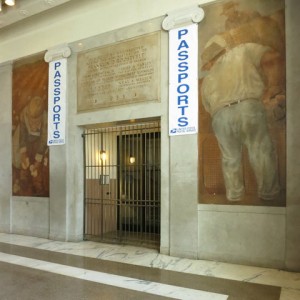Journalist Dennis Bernstein sat down with Living New Deal Project Scholar Gray Brechin for a long interview on the fight to save the US Postal Service, as well as post office buildings and murals across the country. Put it together and it’s a battle to preserve public space and the public good.
We’re reprinting the beginning of the interview here; follow the link below for the full text.
Bernstein writes: “There is a growing grassroots movement to save the U.S. Postal Service from right-wing Republicans who want to privatize it and turn over its most lucrative pieces to the likes of Fed Ex and United Parcel Service. Fed Ex and privatizing advocates have lobbied Congress to make this happen.
“DB: I want to read a little bit from this a piece that you blogged in the middle of last year about this: ‘Thousands of post offices stand to be converted to condos, restaurants, real estate offices or demolished to cover the Postal Service’s largely manufactured deficit. Those that rely on the Post Office are protesting the disappearance of this still vital public service but few have registered what this fire sale represents to the nation’s architectural and artistic legacy…’
“….and I guess that’s the door we’re going to come in, Gray Brechin. It’s really one of the remaining peoples’ institutions, if you will. And so maybe you can give us just a little bit of history about how the Post Office evolved and why we need a Post Office when we’ve got the Internet.
“GB: Well, I never imagined I’d be getting into Post Office studies but I sort of got sucked into it because in the last ten years I’ve been studying the New Deal. We’ve been inventorying and mapping it and it got me thinking about The Public, in general. Because what I realized is what the New Deal was, it was a huge expansion of the idea of The Public, or if you like, the commonwealth. That is what we all own. And very often — as with the Post Office — it’s what we’ve paid for. What our parents and our grandparents paid for and built.
“But it also got me interested in the war against the New Deal, against Franklin Roosevelt, and I realized it’s been going on for thirty to forty years. And it really gained strength under President Reagan who was sort of the anti-Roosevelt, you know. Equally as charismatic but to opposite ends.
“And what happened was that these neoliberals, as we now call them, and libertarians began taking over under Reagan. And in 1986 they came up with something called ‘Starve the Beast.’ That came out of the White House. First off, it’s interesting that you would refer to your government as, The Beast. You know that’s a great way to begin distancing people from it, and seeing it as the enemy rather than as us. And Reagan was very good at that. But the idea behind Starve the Beast was that you deliberately bankrupt your government through tax cuts and tax shifts; that is, shifting from progressive to regressive taxes.
“You do this over a long period of time, it’s a long march through the institutions and in doing that you can actually get rid of The Public. And you can actually make a very nice profit from doing so as you privatize what was the commons and take it away from the public that paid for and built it. And that’s essentially what’s happening with the Post Office.
“I’ll tell you another thing that happened because what’s happening to the Post Office is linked to what’s happening to public education, public parks, etc. In the 1990s, I was teaching geography and I gave a tour of the San Francisco Presidio, which was just being transferred from the Army to the Park Service at that time. And as I was taking the students into a building, one of the new rangers took me aside and said ‘Watch this very carefully.’ He said, ‘No other national park has been required to turn a profit.’ He said, ‘This is the entering wedge for what they are going to do to the national parks.’
“And sure enough, what happened was that the Presidio Trust which is appointed by the President is mostly real estate people. So the Presidio serves as a kind of model for what could happen to the other national parks, particularly if we go off the fiscal cliff and there’s no money to operate them anymore. And that’s essentially what happened to the Post Office. In 2006, the Postal Accountability and Enhancement Act was passed by Congress, a paid Congress I might add, paid by UPS and Fed Ex and Pitney Bowes and other companies. …”
